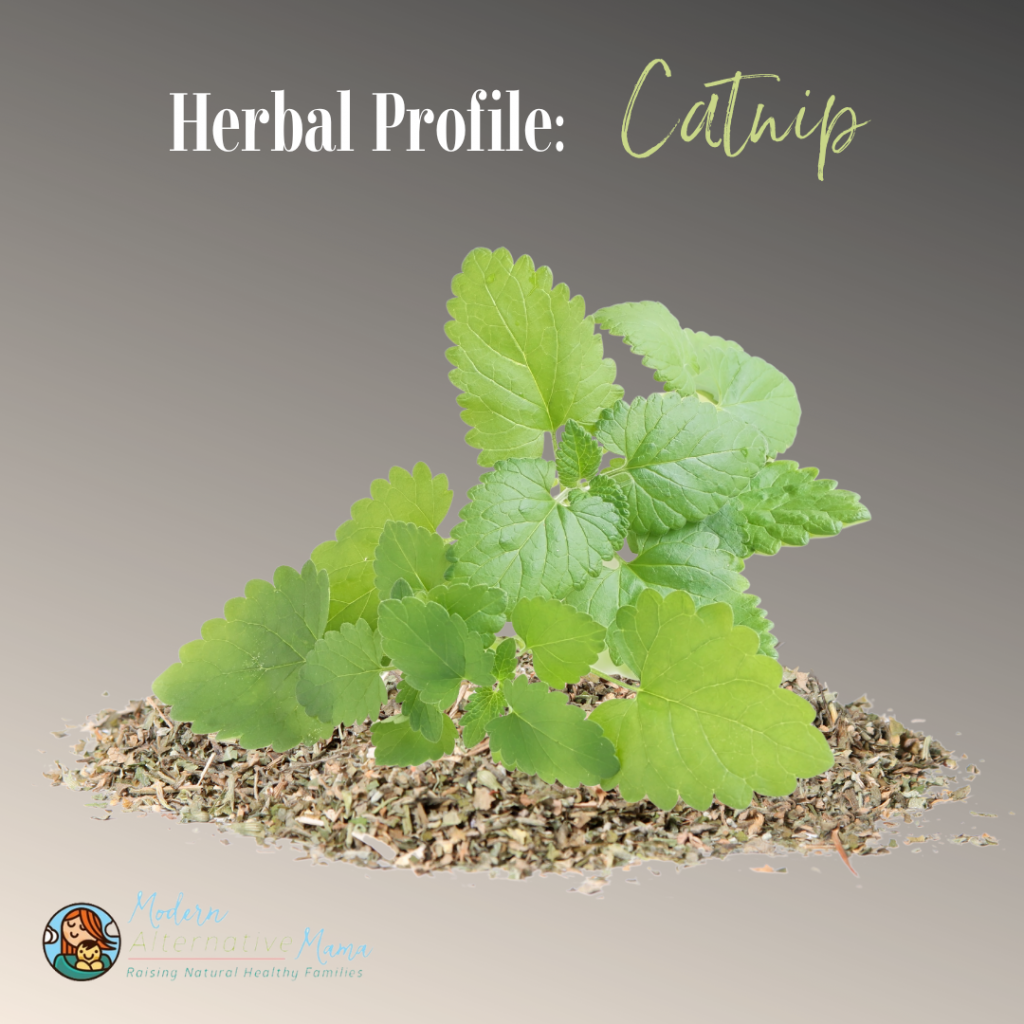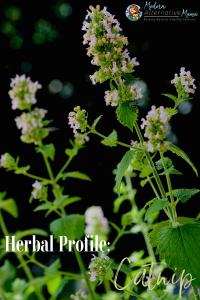What is Catnip
Catnip isn’t just for cats! You know the funny things your cat does on catnip? It’s estimated that approximately 50 to 70 percent of cats are sensitive to catnip. The sensitivity produces exciting reactions; it’s all genetics (1). Compared to cats, catnip has the complete opposite effect on humans.
Catnip, also known as Catmint, catwort, field balm, or its botanical name Nepeta cataria, is a strong-smelling herb (dried is very faint) with dark green, oval tooth-shaped leaves, and white flowering tops. Catnip is native to Central Europe and belongs to the Lamiaceae (mint) family (2).
Health Benefits of Catnip
Unlike cats, the medicinal purposes of catnip is not based on genetics and can help with many ailments, including:
May Promote Sleep & Relieve Insomnia
Some health professionals recommend Nepeta cataria as a mild sedative for those struggling with nervous exhaustion or insomnia. Catnip contains nepetalactone, similar to valepotriates found in valerian, another commonly-used herbal sedative (3). Catnip is relaxing without making you feel drowsy or groggy. It’s a healthy type of calm that’s safe to use even if you need to remain awake for a while. Combining other mildly sedating herbs with catnip like chamomile, passionflower, lemon balm, or skullcap can add additional sedative-like benefits (4).
May Relieve Stress & Anxiety
Catnip has a calming and sedative-like effect that may also benefit those struggling with stress and anxiety. Catnip promotes relaxation and can benefit those with chronic stress and anxiety while supporting overall mental health (5). Some herbalists even use catnip to help calm children with hyperactivity (6).
May Relieve Coughs, Cold, Fevers & Asthmatic Symptoms
Catnip is often used to help manage cold symptoms, like a cough or fever, as well as asthmatic symptoms. Studies have found that Nepeta cataria has antispasmodic and bronchodilatory properties to soothe these symptoms (7). These benefits become greater when you combine catnip with other herbs, like licorice root or mullein (8).
Catnip is also a diaphoretic herb, which means it can help the body sweat out a fever by inducing perspiration and assisting the body in ridding itself of infections more quickly (9).
May Reduce Inflammation & Pain
Catnip has anti-inflammatory benefits that help ease pain and inflammation internally and externally. Catnip has traditionally been used for relieving arthritis, gout, headaches, and aching muscles and can also be used to ease menstrual cramps and gastrointestinal pain (10).
May Help With Gastrointestinal Disorders
Catnip has antispasmodic properties, meaning it can calm indigestion and cramps. Catnip also acts as a carminative, meaning it can relieve gas and help ease constipation and bloating. The anti-inflammatory benefits of the herb calm inflammation in the digestive system and help manage pain (11). These benefits are why we added Catnip to Earthley’s Infant Tummy Relief.
Potential To Be Used For Anticancer Treatment
Recent research has been looking at the potential for Nepeta cataria to be used as an anticancer treatment in humans. Nepeta cataria was essential in anticancer therapy as far back as Traditional Chinese Medicine. One study investigated the effect of total flavonoid extracted from Nepeta cataria L. (TFS) through human lung cancer cell line A549 based on the microfluidic device and Flow Cytometry. They concluded that TFS might be a novel therapeutic agent for non-small cell lung cancer in the near future (12).
Insecticidal Properties
An insecticidal property is when a substance, or in this case, an herb, can kill, harm, repel or mitigate one or more species of insects (13). One study found that catnip repelled mosquitoes more effectively than DEET (14), a toxic ingredient in most mainstream bug repellants.
Safety Concerns
The mainstream narrative will tell you to avoid catnip due to uterine modulator properties, so it won’t cause contractions or loss of baby, but it will act on the uterus to keep it healthy.
Richard Whelan, a trusted herbalist since 1989, has had a single documented adverse reaction with this herb, but none during pregnancy. He states catnip is a highly safe herb that may be freely taken by young or old and during pregnancy and breastfeeding with no concern for toxicity (15).
Remember, not every herb is for every person, and if you don’t feel right while using it, discontinue.
How to Use Catnip
You can find catnip in dried bulk, teas, capsules, powders, extracts, essential oils, and even herbal tinctures. Tinctures always contain the most concentrated amount of herbs. Teas are also options. If you’re a DIY person, some great starter recipes are:
Follow the recommendations of any supplement; some of my recommendations include:
Earthley’s Anxiety Relief is full of adaptogenic herbs. Adaptogens help the body manage stress, remain calmer, and gently balance stress hormones. They benefit adrenal function, and healthy adrenals equal a healthier stress response. Combine those with gently relaxing and calming herbs, and you have a recipe for a good day! Anxiety Relief can relieve anxious feelings, improve mental clarity, decrease mild insomnia, and more!
Earthley’s Calm and Clarity can help promote an even mood and a clearer mind. It can help your kiddo make it through the school day and help you make it through your work day. We include nourishing herbs high in natural vitamins and minerals and promote mental focus. Symptoms of anxiety and attention disorders may be reduced by taking Calm and Clarity. Feel more focused and have a sense of calm without pharmaceuticals!
Earthley’s Infant Tummy Relief is special for little tummies but works for stomach upsets of all ages. It can help relieve pain associated with occasional gas, bloating, and even those pesky hiccups that babies are susceptible to. Unlike traditional gripe water, Infant Tummy Relief is free from artificial flavors, sweeteners, and preservatives.
Earthley’s Mama’s Tummy Relief supports healthy liver function, banishes bloating and nausea, and promotes gut health. While it was formulated for expecting mamas, it’s also perfect for anyone with a general stomach upset!
Earthley’s Natural Balance is made for women struggling with the ups and downs of hormones. This herbal remedy can help steady hormone levels and provide increased energy, calmness, and sleep quality. It is made with all-natural ingredients without those OTC medications that have unwanted side effects.
Earthley’s Nourish Her Naturally was formulated specifically for women to fortify, improve, and nurture the female body. This tincture includes herbs packed with vitamins and minerals to help balance hormones, boost energy levels, and promote overall wellness.
Earthley’s Postpartum Balance was created especially for mamas to help break down no-longer-needed pregnancy hormones, support hormone balance, and helps to lessen bleeding for an easier fourth trimester.
Earthley’s Pregnancy Tea is a nourishing brew to support a healthy pregnancy! Every mom wants to ensure she and the baby get everything they need. Pregnancy Tea can help! This herbal formula contains all the nutrients you may miss in one tea blend.
Earthley’s Sleepy Time Herbal Extract combines three powerful yet gentle herbs that promote restful sleep and peaceful nights. This herbal tincture is the perfect natural solution for the whole family.
Earthley’s Teeth Tamer naturally soothes pain, drooling, and irritability due to tooth pain. Instead of using harmful medications or synthetic gels with unsafe ingredients and potential side effects, experience the relieving power of herbs. Whether you’ve got a toothache or a teething baby, Teeth Tamer is the best natural solution!
Disclaimer: This post is not intended as medical advice. These statements have not been evaluated by the FDA, and nothing in this post is intended to diagnose, treat, or cure anything. If you have questions, please do your own research or seek advice from a health professional.








I’ve been nibbling on a leaf from our bush in the yard and it calms me right away.
I love that you have access to such a beneficial plant, right in your yard. There are so many great remedies you can make with catnip.